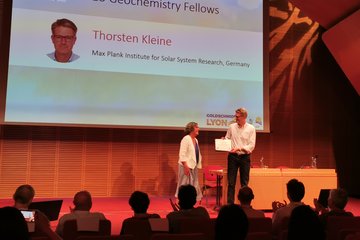Alle Typen
41.
Zeitschriftenartikel
First multispacecraft ion measurements in and near the Earth's magnetosphere with the identical Cluster ion spectrometry (CIS) experiment. Annales Geophysicae 19 (10/12), S. 1303 - 1354 (2001)
42.
Zeitschriftenartikel
Plasma density distribution along the magnetospheric field: RPI Observations from IMAGE. Geophysical Research Letters 28, S. 4521 - 4524 (2001)
43.
Zeitschriftenartikel
Auroral zone dayside precipitation during magnetic storm initial phases. Journal of Atmospheric and Solar-Terrestrial Physics 63, S. 513 - 522 (2001)
44.
Zeitschriftenartikel
Interplanetary shocks, magnetopause boundary layers and dayside auroras: The importance of a very small magnetospheric region. Surveys in Geophys. 22, S. 101 - 130 (2001)
45.
Zeitschriftenartikel
Comment on 'Simulation Study on Fundamental Properties of the Storm-Time Ring Current' by Y. Ebihara and M. Ejiri. Journal Geophysical Research 106, S. 6321 - 6322 (2001)
46.
Zeitschriftenartikel
Electric fields and plasma flow: What drives what? Geophysical Research Letters 28, S. 2177 - 2180 (2001)
47.
Zeitschriftenartikel
Book review ``Physics of the Space Environment'' by Tamas I. Gombosi. EOS 81, S. 149 (2000)
48.
Zeitschriftenartikel
Reply. Journal Geophysical Research 105, S. 27843 (2000)
49.
Zeitschriftenartikel
Outflow of Ions from Ganymede: A Reinterpretation. Geophysical Research Letters 27, S. 1347 - 1349 (2000)
50.
Zeitschriftenartikel
Reply. Journal Geophysical Research 104, S. 7051 (1999)
51.
Zeitschriftenartikel
A note on current closure. Journal Geophysical Research 104, S. 25143 - 25144 (1999)
52.
Zeitschriftenartikel
Current understanding of magnetic storms: storm-substorm relationships. Journal Geophysical Research 103, S. 17705 - 17728 (1998)
53.
Zeitschriftenartikel
Substorm research moves toward a unifying framework. EOS, Trans. AGU 79, S. 329 - 331 (1998)
54.
Zeitschriftenartikel
OH in Saturn's magnetosphere: observations and implications. Journal Geophysical Research 103, S. 20245 - 20255 (1998)
55.
Zeitschriftenartikel
A two-dimensional model of plasma transport and chemistry in the Jovian magnetosphere. Journal Geophysical Research 103, S. 19901 - 19913 (1998)
56.
Zeitschriftenartikel
Electron temperature profiles in the magnetosphere of Neptune. Planetary and Space Science 45, S. 1023 - 1030 (1997)
57.
Zeitschriftenartikel
Geometry of the plasma sheet in the midnight-to-dawn sector of the Jovian magnetosphere: Plasma observations with the Galileo spacecraft. Geophysical Research Letters 24, S. 869 - 872 (1997)
58.
Zeitschriftenartikel
RAPID: The Imaging Energetic Particle Spectrometer on Cluster. Space Science Reviews 79, S. 399 - 473 (1997)
59.
Zeitschriftenartikel
Plasma observations at Io with the Galileo spacecraft. Science 274, S. 394 - 395 (1996)
60.
Zeitschriftenartikel
Plasma temperature profiles in the magnetosphere of Neptune. Journal Geophysical Research 100, S. 19551 - 19557 (1995)











